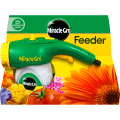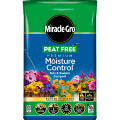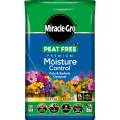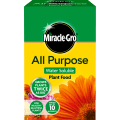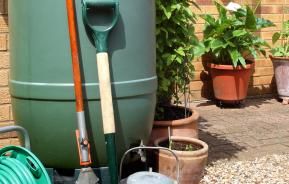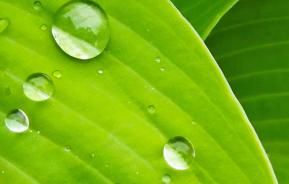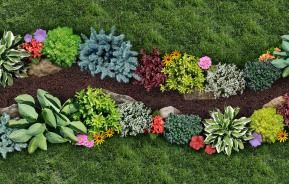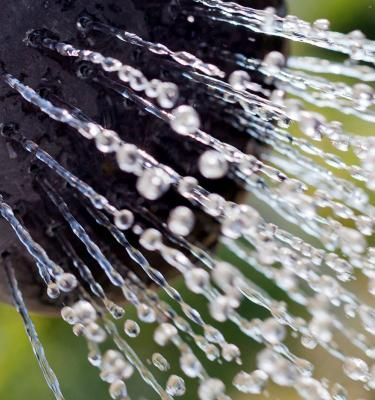
How to water plants properly
Read our guide all about watering plants
Normal rainfall will keep most plants growing in outdoor beds and borders happy for most of the year. Only in hot, dry summers supplementary watering is needed. Plants growing in pots, hanging baskets, tubs, window boxes and other containers will need watering regularly.
Water roots not surface
If your garden is suffering from drought, water plants thoroughly once a week rather than damping the surface every day. Daily dribbles that just wet the surface just encourage roots to develop near the surface. If you sink a pot or tube beside plants the water you deliver will go several centimetres below ground level where it goes immediately to roots bypassing the surface.
You can get a specialised extension to convert any standard hose into a versatile and useful watering device. They have a switch for either watering only or watering and feeding, and a rotating rose head that gives three different spray patterns; a soft and easy sprinkler for delicate flowers; a high volume jet for established shrubs, plants and lawns and a flat wide spray pattern for beds and borders.
Plants growing in outdoor beds and borders
Shrubs, trees and herbaceous plants: Most permanent trees, shrubs, fruit bushes and plants that appear every year have a good deep root system. You can help water retention of the soil with a mulch of organic matter applied around the root area each year. This reduces waste from surface evaporation and will gradually be pulled down below the surface by worms to increase the water-holding capacity of all soils. Apply in early spring when soils are thoroughly wet.
Flowering bedding plants: Flowering bedding plants and vegetables growing in garden soil will need watering occasionally as they have a limited root system. Depending on the weather, they may need watering once a week in a normal year, and more frequently in a summer drought.
Fruit and vegetables: Moist soil conditions are top priority when plants are small and again when the crop is swelling. See that seedlings and small plants are well watered just after they have been transplanted. If you add a dose of soluble plant food to the watering can you will also be feeding the young plants when they need it most. Watering fruit plants and bushes as the fruit swell is beneficial if rainfall is lacking. Some vegetables including runner beans, tomatoes, marrows, courgettes and sweetcorn will produce a heavier crop if they are given supplementary watering.

Plants growing in pots and containers
Flowering bedding plants: Plants growing in hanging baskets, pots, window boxes and other containers will need watering as the compost dries out. In the height of summer this may mean watering daily. To reduce evaporation from terracotta pots, line them with polythene before planting. Planting in good potting compost will help watering because the material will absorb twice as much water as ordinary multi-purpose composts. For thorough watering a saucer below each pot will retain water for some time and be gradually absorbed by the compost from below. Tip out any excess that sits in the saucer for more than 1 hour.
Vegetables: Plants that appreciate good drainage and regular feeding will produce a good crop when grown in pots and containers. Tomatoes, chilli pepper, sweet peppers, French beans and aubergines are guaranteed performers when grown in an assisted vegetable growing kit. While runner beans need a larger container such as a half barrel to provide the cool root run that they prefer. Again use the best compost you can afford and keep the compost moist at all times.
Roses and shrubs: Keep the compost moist at all times as dryness at the roots will tend to encourage powdery mildew to form on rose leaves.
Acid-loving plants: If you are growing rhododendrons, azaleas and other acid loving plants in containers plant them in an ericaceous compost and try to use rain water stored in a water butt to keep the compost moist at all times. Rainwater is naturally acid whereas some drinking water is generally more alkaline. If your kettle furs up, then your tap water is hard and not really suitable for use on acid-loving plants growing in pots.
Feed your garden in just 15 minutes
Watering patio pots, hanging baskets and flowering garden plants is an essential part of modern-day gardening and most of us have a hosepipe to help with the job. Now it is possible to purchase an extension feeder that can be quickly fitted to the end of any standard hose and turns it into a valuable watering and feeding tool.
These feeder extensions come complete with a free hose connector and is filled with plant food so it is ready to use when you buy it. Features include an on/off trigger set into the easy-grip ergonomic handle with locking device, a switch for either watering only or watering and feeding, and a rotating rose head that gives three different spray patterns; a soft and easy sprinkler for delicate flowers; a high volume jet for established shrubs, plants and lawns and a flat wide spray pattern for beds and borders.
The plant feeding extension is designed to automatically dissolve and dispense soluble plant food and soluble lawn food. Feeding or watering the whole garden in just a few minutes is now effortless and fun - it can take only 15 minutes to treat the average sized garden.

